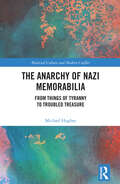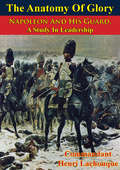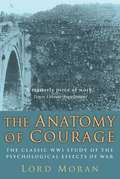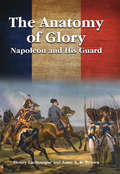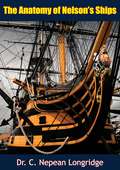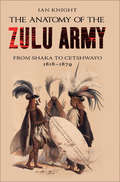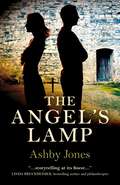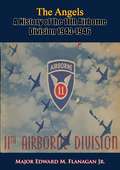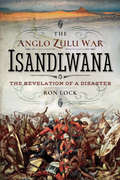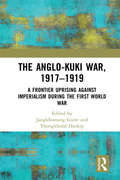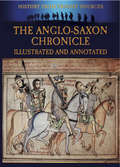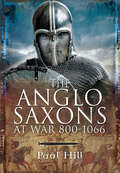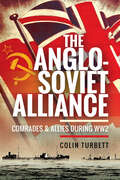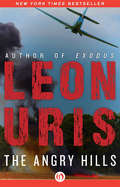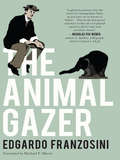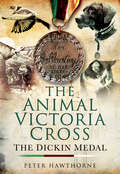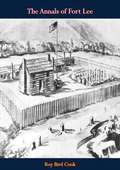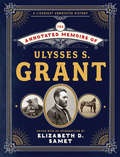- Table View
- List View
The Anarch Lords (John Grimes)
by A. Bertram ChandlerHis wild career as a space pirate ended, Grimes faced his toughest assignment - he was "punished" by being made governor of the anarchists' own planet! John Grimes, living legend of the spaceways, had been in and out of some cosmic catastrophes but this threatened to reach his luck's ultimate breaking point!An influx of planetary refugees had made that world a paradise of cheap labor and the original anarchist colonists had become such masters of wealth that no mere outsider could hope to dictate "law and order" to them. They had their own ideas which included slavery, treachery, and utter villainy.Grimes' first task as governor would be simply to stay alive with a whole world plotting his murder!
The Anarchy of Nazi Memorabilia: From Things of Tyranny to Troubled Treasure (Material Culture and Modern Conflict)
by Michael HughesCompared to the numerous books and articles on the Third Reich, few address its material culture, and fewer still discuss the phenomenon of Nazi memorabilia. This is all the more surprising given that Nazi symbols, so central to sustaining Hitler’s movement, continue to live long after the collapse of his 12-year Reich. Neither did Nazi ideology die, far-right populists would like to see the swastika flown over the White House or Buckingham Palace. Against a backdrop of right-wing extremism, military re-enactors think nothing of dressing up in Waffen-SS uniforms and romanticising the Third Reich in the name of living history. Auctioneers are prepared to hammer down Nazi artefacts to the highest bidder, but who is buying them, and why do they do so? Should collectors be allowed to decorate their homes with Nazi flags? The Anarchy of Nazi Memorabilia begins by examining the creation and context of Nazi artefacts and symbols during the volatile Weimar Republic to their wider distribution during the Third Reich. There were few people in Nazi Germany who did not wear a badge or uniform of some sort. Whether it be mothers, soldiers or concentration camp inmates, they were all branded. The chapter on the Second World War even demonstrates that German soldiers were highly cynical about being given medals in exchange for freezing in Russia. They still continued to fight, however, for which more decorations were awarded. A large proportion of this book is therefore given to the meaning that Nazi symbols had before Nazi Germany was eventually defeated in May 1945. Equally important, however, and one of the characteristics of this book, is the analysis of the meaning and value of Nazi material culture over time. The interpreters of Nazi symbols that this book focuses on are internationally based private collectors and traders. Sustained attention is given in a chapter outlining the development of the collectors’ market for Nazi memorabilia from 1945 onwards. No matter how much collectors go out of their way to paint the hobby in a positive light, their activities are not fully able to escape the troubled past of the material that they desire. So contested are Nazi symbols, that another chapter is devoted to the ethics and morals of destroying or preserving them. As part of this chapter the issues surrounding private versus public custody and ownership of Nazi artefacts are also discussed. So far, in this book, the examination of Nazi artefacts has been restricted to physical objects within societies that are generally aware of the consequences of Hitlerism. As we increasingly move into the digital age, however, and there are few survivors of the Second World War left to relay their horrific experiences, the final chapter contemplates the future of Nazi symbols both digitally and physically, fake or real. This book will appeal to all those interested in the Third Reich, Nazi Ideology, Neo-Nazism, perceptions of the Nazis post-1945, Modern European History and political symbolism. It will also hold particular appeal to those interested in the collecting and trading of contested and highly emotive artefacts. It considers aesthetics, authenticity, commodification, gift exchange, life histories of people and objects, materiality and value theory.
The Anatomy Of Glory; Napoleon And His Guard, A Study In Leadership
by Anne S. K. Brown Commandant Henri LachouqueThe glory of the Imperial Guard resounds above all others in the annals of war. Created, built and nurtured as a bodyguard for Napoleon, it grew from a brigade of less than two thousand men into a virtual army, and became ‘a human fortress which no one but he could dominate and no enemy could penetrate’. And, on such battlefields as Austerlitz, Jena, Friedland, Wagram and Waterloo, it won the laurels of undying fame.Written by France’s foremost historian of the Napoleonic Wars, Commandant Henry Lachouque, and translated and adapted by Anne S. K. Brown, this sumptuous work is enhanced by over 180 illustrations, including 86 plates in full colour.With its vivid narrative and lavish illustrations, The Anatomy of Glory can lay justifiable claim to be one of the most magnificent books on military history ever published. The critical acclaim that greeted it upon its first publication provides ample testimony to its reputation:‘This dramatic account of the birth, life and death of the fabulous Imperial Guard tells a stirring story in English for the first time.’-The Saturday Review of Literature.‘No one but the most presumptuous who wishes to know about the Imperial Guard can afford to ignore this astonishing compilation. The illustrations alone...are reproduced with a clarity, a beauty, and technical perfection which no one can fail to admire.’ Journal of the RUSI.‘This sumptuous book ... can yield rich rewards to any reader interested in the fabric of leadership. It is a delight to look at and a pleasure to read.’ -The New York Times.`... Not the well-worn history of conquest and defeat, but of the grognards themselves, marching through readable pages.’ -History Today.‘Anne S. K. Brown has used her knowledge of French history and uniforms to render Lachouque freely and vigorously. Napoleon just happened to be fallible. But the superb apparatus of his fallibility is gorgeously recalled in this volume.’ The Scotsman.
The Anatomy of Courage: The Classic WWI Study of the Psychological Effects of War
by John Moran'I set out to find how courage is born and how it is sustained in a modern army of a free people. The soldier is alone in his war with terror and we have to recognise the first signs of his defeat, that we may come in time to his rescue.' Lord MoranFirst published in 1945 this early, groundbreaking account of the psychological effects of war, recounted by means of vivid first-hand observation and anecdote, came at a time when shell-shock was equated with lack of moral fibre. In 1940, Moran became Churchill's doctor and his position as a one of history's most important war physicians was secured. His humane, considered observations, scientific analysis and proposed solutions constitute one of the great First World War sources. However, they are perhaps just as relevant to our own conflict-ridden times.Charles McMoran Wilson was awarded the MC during the Battle of the Somme and the Italian Silver Medal for Military Valour. He was the Dean of St Mary's Hospital Medical School, became Winston Churchill's doctor in 1940 and was President of the Royal College of Physicians. He is also the author of Churchill: The Struggle for Survival and Churchill at War.PRAISE FOR THE ANATOMY OF COURAGE'A remarkably human book ... arresting, and sometimes even unforgettable.' Desmond McCarthy, Sunday Times'A fascinating book ... It is not easy to do justice to Lord Moran's discursive brilliancy ... a masterly piece of work.' Times Literary Supplement
The Anatomy of Courage: The Classic WWI Study of the Psychological Effects of War
by Lord John Moran'A remarkably human book . . . arresting, and sometimes even unforgettable' Desmond McCarthy, Sunday Times'A fascinating book . . . It is not easy to do justice to Lord Moran's discursive brilliancy . . . a masterly piece of work' Times Literary Supplement'I set out to find how courage is born and how it is sustained in a modern army of a free people. The soldier is alone in his war with terror and we have to recognise the first signs of his defeat, that we may come in time to his rescue' LORD MORANDuring the First World War, Lord Moran served as a medical officer in the Royal Fusiliers for two-and-a-half years. He won the Military Cross and the Italian Silver Medal for Valour. During these years in the trenches he watched closely the soldiers' conduct under stress. The Anatomy of Courage is his sensitive and scientific study of fear and anxiety. First published in 1945 this early, ground-breaking account of the psychological effects of war, recounted by means of vivid first-hand observation and anecdote, came at a time when shell-shock was equated with lack of moral fibre. In 1940, Moran became Churchill's doctor and his position as a one of history's most important war physicians was secured. His humane, considered observations, scientific analysis and proposed solutions constitute one of the great First World War sources. However, they are perhaps just as relevant to our own conflict-ridden times.
The Anatomy of Glory: Napoleon and His Guard
by Henri Lachouque Anne S. BrownNapoleons Imperial Guard was arguably the most famous military formation to tread the battlefields of Europe. La Garde Imperial was created on 18 May 1804, and from its origins as a small personal escort, the Guard grew in size and importance throughout the Napoleonic era. Eventually, it became the tactical reserve of the Grande Arme, comprising almost a third of Napoleons field forces. The men of the Imperial Guard were the lite of the First Empire, its officers and men the military aristocracy of post-Revolutionary France.Used only sparingly, the Guard acquired a reputation of invincibility. Such had become its prestige, when the attacks of the Guard were repulsed at Waterloo, they signaled not only the defeat of the French army but also the end of an era.In this magnificent study, unparalleled in depth and scope, the renowned French historian Commandant Henry Lachouque has produced a lavish and sumptuous work. It combines vivid narrative with valuable and unique uniform illustrations, including seventy-four full color plates from the Anne S.K. Brown collection, to make The Anatomy of Glory one of the most important and most sought-after books on military history ever published.
The Anatomy of Nelson’s Ships
by Dr C. Nepean LongridgeThe history of Admiral Horatio Nelson has been written from every possible angle, but this was not so with his ships. Not until this work was first published in 1955. Before then, such information as there was about the ships was buried in archives on Naval Architecture; only the top expert could have sifted it and present it in a usable form.Dr. Longridge was that expert, and his work became a veritable treasure trove for every naval historian and ship modeller.His research is supported by 271 detailed line drawings, rare photographs and fold-out plans showing hull framing, interior construction, complexing and deck layouts.
The Anatomy of Peace
by Emery Reves“Open Letter to the American People”, signed by Owen J. Roberts, J.W. Fulbright, Claude Pepper, Elbert D. Thomas, and other dignitaries:“The first atomic bomb destroyed more than the city of Hiroshima. It also exploded our inherited, outdated political ideas.“A few days before the force of Nature was tried out for the first time in history, the San Francisco Charter was ratified in Washington. The dream of a League of Nations, after 26 years, was accepted by the Senate.“How long will the United Nations Charter endure? With luck, a generation? A century? There is no one who does not hope for at least that much luck- for the Charter, for himself, for his work, and for his children’s children. But is it enough to have Peace by Luck? Peace by Law is what the peoples of the world, beginning with our selves, can have if they want it. And now is the time to get it.”The Anatomy of Peace by Emery Reves, first published in 1945, is a book that expressed the world federalist sentiments shared by Albert Einstein and many others in the late 1940s, in the period immediately following World War II.Reves argued that world law was the only way to prevent war, and the fledgling United Nations Security Council would be inadequate to preserve peace because it was an instrument of power, rather than an instrument of law.“I have read THE ANATOMY OF PEACE with the greatest admiration. Your book is, in my opinion, the answer to the present political problems of the world, so drastically precipitated by the release of atomic energy.“It would be most desirable if every political and scientific leader in every country would take a little time to read this book. If this could be brought about, I feel it might avert the disaster of an atomic world war.”—Letter from Albert Einstein to Emery Reves dated October 29, 1945.
The Anatomy of a Raid: Australia At Celtic Wood, 9th October 1917: The Broodseinde Ridge _ Third Battle Of Ypres (Cameos Of The Western Front Ser.)
by Ted SmithA seemingly unnecessary raid made by men of the 10th Battalion A.I.F. on Celtic Wood, Broodseinde on the 9th October 1917 resulted in the unrecorded deaths of 37 of the raiding party. The mystery of how they died has never been solved. The conclusion reached in this book prompts thoughts as to why the military authorities never conducted an investigation at the time, and why the raid was planned in the first place.
The Anatomy of the Zulu Army: From Shaka to Cetshwayo, 1818–1879 (Greenhill Military Paperback Ser.)
by Ian KnightAn in-depth look at the army of Africa&’s Zulu kingdom leading up to their epic battle against the British army in 1879. Forces of the independent Zulu kingdom inflicted a crushing defeat on British imperial forces at Isandlwana in January, 1879. The Zulu Army was not, however, a professional force, unlike its British counterpart, but was the mobilized manpower of the Zulu state. Ian Knight details how the Zulu army functioned and ties its role firmly to the broader context of Zulu society and culture. The Zulu army had its roots in the early groups of young men who took part in combat between tribes, but such warfare was limited to disputes over cattle ownership, grazing rights, or avenging insults. In the early nineteenth century the Zulu nation began a period of rapid expansion, and King Shaka began to reform his forces into regular military units. Ian Knight charts the development and training of the men that formed the impi, which later operated so successfully under King Cetshwayo. Knight analyzes the Zulu&’s fighting methods, weapons, and philosophy, all of which led to the disciplined force that faced the British army in 1879.&“For me, this is the Zulu bible—everything you need to know about this warrior race over a 60-year period during the 19th Century. The battles fought are legendary and well covered many times over in other books, but Knight&’s &“anatomy&” goes much deeper. The book explains why the Zulu Army was so fearsome and effective, by exposing how each warrior was virtually nurtured into the role from birth and remained loyal until death.&” —David H. Smith, Military Modelling
The Angel's Lamp
by Ashby JonesThe Angel&’s Lamp, set in war-torn Ireland just after the Easter Rising, centers around a love affair between Johnny Flynn, an Irish-bred, English staff-sergeant in charge of the rebellion's soon-to-be executed leaders, and Nora Connolly, the firebrand daughter of James Connolly, the uprising&’s charismatic leader. Johnny meets Nora while standing guard over her soon-to-be executed father and is struck by her determination to take the fight to the British. But then, unknown to Nora and under the threat of death Johnny is unexpectedly summoned to serve on the firing squad that executes Connolly. Ridden with guilt after the execution and feeling a traitor to his heritage given all he has seen and done, Johnny deserts the British Army, joins the ragtag Irish rebels, and soon crosses paths with Nora. The story that follows culminates in an fiery emotional conflict between Johnny and Nora that pits the possibilities of love against the unyielding obstacles to forgiveness.
The Angels: A History of the 11th Airborne Division 1943-1946
by Major Edward M. Flanagan Jr.This is the definitive account of the history of the U.S. Army’s 11th Airborne Division (The Angels) from 1943-1946, by then-Major Edward M. Flanagan, Jr. who served with that division in the Pacific War.“The Division was activated at Camp Mackall, N. Carolina on Feb. 25, 1943, and was composed of former glider and veteran Airborne troops. Upon activation, the Division began intensive training to get the glider troops jump-qualified, and the Division was ready to move overseas in early 1944. Sent first to New Guinea for training in jungle combat, the Division took part in the Leyte landings in the Philippines in Nov. 1944. Moving inland, the unit relieved the battle-weary 24th and 37th Inf. Divs. with the mission to clear a mountain pass from Burauen to Ormoc. It took 3 months of bitter fighting, often hand-to-hand, to drive the Japanese defenders from the pass and surrounding heights.In late January, 1945, the 11th went back into action after a short rest, landing at Nasgubu Beach, Luzon, 70 miles from Manila. Their objective was to remove enemy opposition from a major highway and link with Allied forces attacking Manila. After capturing Fort McKinley and Nichols field, the 11th launched their assault on Manila joining the 1st Cav. Div. and the 37th Inf. Div. who were attacking from the North. Once the capitol was secured, the 11th made a daring raid behind enemy lines and freed more than 2,100 Allied civilian and military POWs from the Los Baños Internment Camp, considered one of the most successful rescues in military history. Following the Los Baños raid, the 11th Airborne spent the next few weeks mopping up resistance in southern Luzon.In May, 1945, the Division began preparations for the expected invasion of Japan, but with Japan's surrender in August, the Division instead moved to Okinawa to escort Gen. Douglas MacArthur into Japan. The 11th Airborne remained in Japan until 1949 before returning to the U.S.”-print ed.
The Anglo Zulu War: The Revelation of a Disaster
by Ron LockA concise history of the Battle of Isandlwana, the first encounter of the Anglo-Zulu War in 1879.In 1878, H.M. High Commissioner for Southern Africa and the Lieut. General Commanding H.M. Forces, clandestinely conspired to invade the Zulu Kingdom. Drastically underestimating their foe, the invaders had been vanquished within days of entering the Zulu Kingdom, in one of the greatest disasters ever to befall a British army.The author not only dramatically describes the events leading up to the Battle of Isandlwana, and the battle itself but, with new evidence, disputes many aspects of the campaign long held sacrosanct.Praise for The Anglo Zulu War: Isandlwana“It offers a controversial but compelling account of the battle that underlines the consequences of operational arrogance and underestimating the fighting abilities of a less technologically equipped enemy – something that should resonate with all those who serve.” —Soldier“This is a book that should be on the bookshelves of everyone who is interested in the history of South Africa.” —The South African Military Society
The Anglo Zulu War: The Revelation of a Disaster
by Ron LockA concise history of the Battle of Isandlwana, the first encounter of the Anglo-Zulu War in 1879.In 1878, H.M. High Commissioner for Southern Africa and the Lieut. General Commanding H.M. Forces, clandestinely conspired to invade the Zulu Kingdom. Drastically underestimating their foe, the invaders had been vanquished within days of entering the Zulu Kingdom, in one of the greatest disasters ever to befall a British army.The author not only dramatically describes the events leading up to the Battle of Isandlwana, and the battle itself but, with new evidence, disputes many aspects of the campaign long held sacrosanct.Praise for The Anglo Zulu War: Isandlwana“It offers a controversial but compelling account of the battle that underlines the consequences of operational arrogance and underestimating the fighting abilities of a less technologically equipped enemy – something that should resonate with all those who serve.” —Soldier“This is a book that should be on the bookshelves of everyone who is interested in the history of South Africa.” —The South African Military Society
The Anglo-Kuki War, 1917–1919: A Frontier Uprising against Imperialism during the First World War
by Jangkhomang Guite Thongkholal HaokipThis book explores the Kuki uprising against the British Empire during the First World War in Northeast frontier of India (then Assam-Burma frontier). It underlines how of the three-year war (1917–1919), spanning over 6,000 square miles, is crucial to understanding present-day Northeast India. The essays in the volume examine several aspects of the war, which had far-reaching consequences for the indigenous population as well as for British attitudes and policy towards the region – including military strategy and tactics, violence, politics, identity, institutions, gender, culture, and the frontier dimensions of the First World War itself. The volume also looks at how the conflict affected the larger dynamics of the region within Asia, and its relevance in world politics beyond the Great War. Drawing on archival sources, extensive fieldwork and oral histories, the volume will be a significant contribution to comprehending the complex geopolitics of the region. It will be of great interest to scholars and researchers of South and Southeast Asian Studies, area studies, modern history, military and strategic studies, insurgency and counterinsurgency studies, tribal warfare and politics.
The Anglo-Saxon Chronicle: Illustrated and Annotated (History From Primary Sources Ser.)
by Bob CarruthersThe essential primary-source history of the British Isles through the early Middle Ages, fully annotated and illustrated with paintings and engravings. The Anglo-Saxon Chronicle is one of the most important sets of historical documents concerning the history of the British Isles. These vital accounts, thought to be first set down in the late ninth century by a scribe in Wessex, illuminate events through the Dark Ages that would otherwise be lost to history. Without this chronicle, it would be impossible to write the history of the English from the Romans to the Norman Conquest. The compilers of this chronicle included contemporary events they themselves witnessed, as well as those recorded by earlier annalists whose work is in many cases preserved nowhere else. With nine known versions of the Chronicle in existence, this translated edition presents a conflation of passages from different versions. Relying heavily on Rev. James Ingram&’s 1828 translation, the footnotes provided are all those of Rev. Ingram. This edition also includes the complete Parker Manuscript.
The Anglo-Saxons at War, 800–1066: At War, 800-1066
by Paul HillIn the time of the great Anglo-Saxon kings like Alfred and Athelstan, thelred and Edmund Ironside, what was warfare really like how were the armies organized, how and why did they fight, how were the warriors armed and trained, and what was the Anglo-Saxon experience of war? As Paul Hill demonstrates in this compelling new study, documentary records and the growing body of archaeological evidence allows these questions to be answered with more authority than ever before. His broad, detailed and graphic account of the conduct of war in the Anglo-Saxon world in the unstable, violent centuries before the Norman Conquest will be illuminating reading for anyone who wants to learn about this key stage of medieval history.The role of violence and war in Anglo-Saxon society is explored, in particular the parts played by the king and the noblemen, and the means by which, in times of danger, the men of the fyrd were summoned to fight. The controversial subject of the Anglo-Saxon use of cavalry is also explored. Land and naval warfare are central sections of Paul Hills book, but he also covers the politics and diplomacy of warfare the conduct of negotiations, the taking of hostages and the use of treachery.The weapons and armor of the Anglo-Saxons are described the spears, the scramsaxes, axes, bows, swords, helmets, shields and mail that were employed in the close-quarter fighting of the day. Among the most valuable sections of the study are those dealing, in vivid detail, with actual experience of battle and siege with the brutal reality of combat as it is revealed by campaigns against the Danes, in the battles of Ashdown, Maldon and Stamford Bridge, and sieges at Reading and Rochester.
The Anglo-Soviet Alliance: Comrades & Allies During WW2
by Colin TurbettConsiders the inter-war and wartime relationship between Britain and the USSR and its impact on the attitudes of ordinary citizens.From the onset of the Bolshevik Revolution in Russia in 1917 until the German invasion of the Soviet Union in 1941, Britain enjoyed an ambiguous relationship with the USSR and its people. All inter-war governments were concerned about the communist ideals of the new state and the threat they presented to British interests at home and abroad, and this was inevitably reflected amongst the general population. However there was a well-established British Communist Party whose fortunes were tied to the Soviet Union’s successes and failures. The wartime alliance offered the Communists an opportunity to extend their influence and win electoral support. Or did it? There were influences at work stemming from both sides that sought to put the importance of allied victory above competing ideology, with agreement over the need for a strong and unconditional anti-Fascist alliance. Compromises were made and relationships formed that would have seemed strange indeed to the pre-war observer. There were, however, tensions throughout the period of the war. By mid-1945, the alliance was threatened by differences that reflected original ideologies that had been glossed over for the duration of the conflict: these led to a Cold War for the next 45 years. This book, using both contemporary sources as well as post-war analyses, examines these matters alongside images that take us back to the period and help us understand its intricacies. It will start with a look at Britain’s opposition to the Bolshevik Revolution and the consolidation of the Soviet State under Lenin and then Stalin. The main body of the book goes on to give detail of the Wartime Alliance and the various forms through which it was expressed – from Government led Lend-Lease of equipment, to voluntary 'Aid for Russia. t ends with the War’s aftermath and the division of the world between the influences of capitalism on the one hand, and the “really existing socialism” of the Soviet Union and its satellites on the other. Tensions and expectations resulted, amongst other great social events, in the launch of the Welfare State, the demise of the British Empire, the nuclear arms race and, ultimately, the end of the Soviet Union in 1991.
The Angry Hills
by Leon UrisA writer moves to Greece just as the Nazis invade, and he soon becomes a pawn in a dangerous game of espionage After the death of his wife, Mike Morrison arrives in Greece simply to receive an inheritance and come to grips with his grief. But it's a bad time to nurse his sorrow--it's the beginning of World War II, and the German army storms the country before Morrison can leave. He's soon caught in a complicated cat-and-mouse game with Gestapo officers, British spies, and the Greek resistance movement. At the mercy of strangers, Morrison has to learn who to trust--and who to love. Leon Uris's fast-paced second novel draws from the diaries of an uncle who served in Greece during World War II. It was made into a film in 1959 starring Robert Mitchum. This ebook features an illustrated biography of Leon Uris including rare photos from the author's estate.
The Animal Gazer
by Edgardo FranzosiniA poignant biographical novel about a WWI-era sculptor: “It’s difficult not to love the eccentric, fragile Rembrandt Bugatti and suffer alongside him” (The New York Times Book Review). The Animal Gazer is a hypnotic novel inspired by the strange and fascinating life of sculptor Rembrandt Bugatti, brother of the fabled automaker. With World War I closing in and the Belle Époque teetering to a end, Bugatti leaves his native Milan for Paris, where he encounters Rodin and casts his bronzes at the same foundry used by the French master. In Paris and then Antwerp, he obsessively observes and sculpts the baboons, giraffes, and panthers in the municipal zoos, finding empathy with their plight and identifying with their life in captivity. But as the Germans drop bombs over the Belgian city, the zoo authorities are forced to make a heart-wrenching decision about the fate of the caged animals, and Bugatti is stricken with grief from which he’ll never recover. Rembrandt Bugatti’s work is displayed in major museums around the world, and in this prize-winning novel, “an irresistible, elegantly conceived example of biographical fiction,” Edgardo Franzosini recreates the young artist’s life with lyricism, passion, and sensitivity (Library Journal). “The Animal Gazer takes you on a glorious journey into the heart of cosmopolitan Paris as you have never known it before. Through the life of Rembrandt Bugatti, a sculptor with the panache of his name, this lively, fast-paced narrative evokes an exceptional epoch in all its color and eccentric charm.” ―Nicholas Fox Weber, author of Le Corbusier: A Life
The Animal Victoria Cross: The Dickin Medal
by Peter HawthorneSeventy-Four animals have won the Dicken Medal, the highest award for animal bravery. Their inspiring stories are told, for the first time in one book, The Animal Victoria Cross. Four types of animal have been honored, dogs, horses, pigeons and one cat. Simon, the feline, is credited with saving an entire ship's crew. Canine breeds include Alsatians, Terriers, Collies and Spaniels. The majority of awards were related to war service and the conflicts include the Second World War, Korea, Iraq, Yugoslavia and Afghanistan. The Al-Qaeda attack on the Twin Towers as well as the Blitz saw great courage exhibited by animals such as Rip, the dog who saved many lives. In addition to British animals, there are American, Canadian, Australian and Egyptian winners of this unique award. This delightful book will be treasured by animal lovers everywhere. It is ideal to 'dip' into or read from cover to cover.
The Animal Victoria Cross: The Dickin Medal
by Peter HawthorneSixty-three animals have won the Dickin Medal, the highest award for animal bravery. Their inspiring stories are told, for the first time in one book, The Animal Victoria Cross. Four types of animal have been honored, dogs, horses, pigeons and one cat. Simon, the feline, is credited with saving an entire ships crew. Canine breeds include Alsatians, Terriers, Collies and Spaniels. The majority of awards were related to war service and the conflicts include the Second World War, Korea, Iraq, Yugoslavia and Afghanistan. The Al-Qaeda attack on the Twin Towers as well as the Blitz saw great courage exhibited by animals such as Rip, the dog who saved many lives. In addition to British animals, there are American, Canadian, Australian and Egyptian winners of this unique award. Animal lovers everywhere will treasure this delightful book. It is ideal to dip into or read from cover to cover.
The Animals at Lockwood Manor
by Jane HealeyA debut novel for fans of Sarah Perry and Kate Morton: when a young woman is tasked with safeguarding a natural history collection as it is spirited out of London during World War II, she discovers her new manor home is a place of secrets and terror instead of protection.In August 1939, thirty-year-old Hetty Cartwright arrives at Lockwood Manor to oversee a natural history museum collection, whose contents have been taken out of London for safekeeping. She is unprepared for the scale of protecting her charges from party guests, wild animals, the elements, the tyrannical Major Lockwood and Luftwaffe bombs. Most of all, she is unprepared for the beautiful and haunted Lucy Lockwood. For Lucy, who has spent much of her life cloistered at Lockwood suffering from bad nerves, the arrival of the museum brings with it new freedoms. But it also resurfaces memories of her late mother, and nightmares in which Lucy roams Lockwood hunting for something she has lost. When the animals appear to move of their own accord, and exhibits go missing, they begin to wonder what exactly it is that they might need protection from. And as the disasters mount up, it is not only Hetty&’s future employment that is in danger, but her own sanity too. There&’s something, or someone, in the house. Someone stalking her through its darkened corridors . . .
The Annals of Fort Lee
by Roy Bird CookFort Lee was built in 1788 on the site of what is now Charleston, West Virginia, at the junction of the Kanawha River and the Elk River. It is named for Virginia Governor Henry (Light Horse Harry) Lee, and played a great part in the Indian wars of that area until they came to an end in 1794. The fort was established by a group of men led by the Clendenin brothers George and William, for whose father Charles the city of Charleston was later named. The fort's early history was fraught with difficulties getting lead, powder and pay (with the capital at Richmond being far away over the mountains), but it contributed to an organized system of defense to stop the Indian raids from driving the settlers from their homes. The book discusses George Washington, who owned property nearby, and Daniel Boone, who was appointed Lieutenant Colonel of the Kanawha and took up residence quite near the fort. Readers will learn of "Mad Ann Bailey," who carried powder unmolested by Indians because they thought her insane, and others whose determination aided frontier defense. Following Mad Anthony Wayne's success against the Indians on the western border, Fort Lee ceased to have any connection with the Virginia military system by the end of 1795, and became simply a residence in Charleston. The fort building was subsequently moved a couple of times and was finally consumed by fire in 1891, except for a couple of logs from which souvenirs were made.-Print ed.
The Annotated Memoirs of Ulysses S. Grant
by Ulysses S. Grant Elizabeth D. SametWith kaleidoscopic, trenchant, path-breaking insights, Elizabeth D. Samet has produced the most ambitious edition of Ulysses Grant’s Memoirs yet published. One hundred and thirty-three years after its 1885 publication by Mark Twain, Elizabeth Samet has annotated this lavish edition of Grant’s landmark memoir, and expands the Civil War backdrop against which this monumental American life is typically read. No previous edition combines such a sweep of historical and cultural contexts with the literary authority that Samet, an English professor obsessed with Grant for decades, brings to the table. Whether exploring novels Grant read at West Point or presenting majestic images culled from archives, Samet curates a richly annotated, highly collectible edition that will fascinate Civil War buffs. The edition also breaks new ground in its attack on the “Lost Cause” revisionism that still distorts our national conversation about the legacy of the Civil War. Never has Grant’s transformation from tanner’s son to military leader been more insightfully and passionately explained than in this timely edition, appearing on the 150th anniversary of Grant’s 1868 presidential election.

